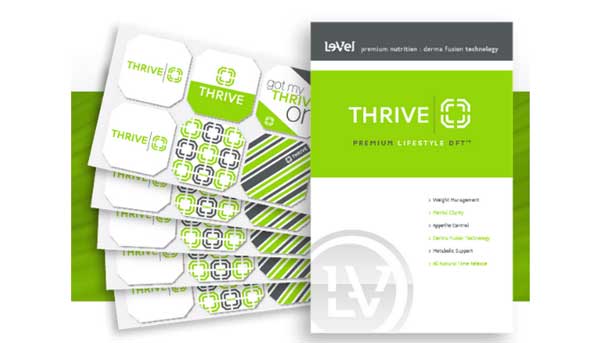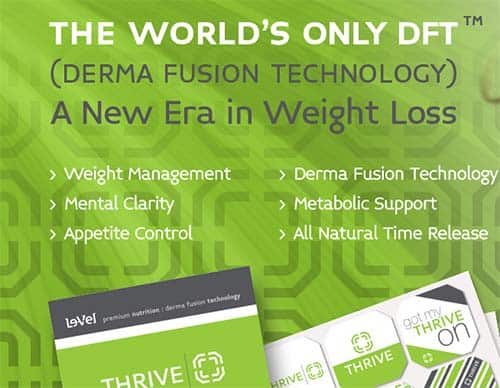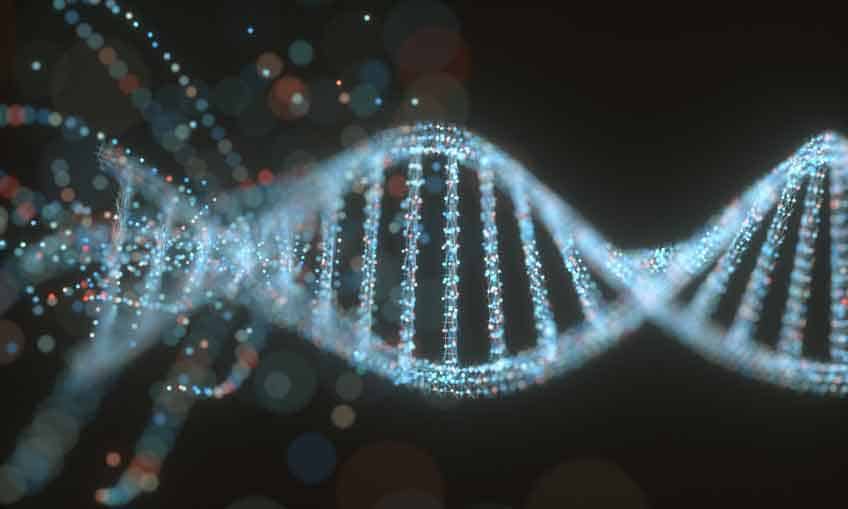DFT Duo weight loss patches utilize Dermal Fusion Technology – which basically means through the skin. Does this diet patch deliver on its promise?

PROS
Great looking brand
Reputable company
CONS
Disappointingly uses MLM
Expensive
VERDICT – LOOK ELSEWHERE
What does it do: Thrive DFT DUO’s purpose is to support lipid metabolism, providing all-day weight management and appetite support.
Pros: Nice looking brand with some good ingredients
Cons: MLM – need we say more
Recommended alternative – if you are set on using a weight loss patch then the Slim Diet Patch is arguably the product this is best in class.
Thrive DFT Diet Patch Review
Diet patches are all the rage these days. Most of the big supplement manufacturing companies have a patch to offer. DFT Duo is of one that has been brought to market by Le-Vel and is sold under the Thrive brand name.
Thrive products are distributed using multi-level marketing (MLM) techniques. For those who are not familiar with the concept, MLM companies distribute their products via distributors and the people who sign-up as distributors always work very hard because they have bought into a dream that promises big bucks and a luxury lifestyle.
A few MLM distributors realize this dream, but the majority do not and products that are distributed in this manner tend to come a poor second to ones that are distributed in more traditional ways.
MLM is a money game. It’s as simple as that. We’re not knocking Thrive DFT Duo because it’s distributed in this way, merely speaking in general, but let’s take a closer look at the product and see how good it’s likely to be.

What Does Thrive DFT Duo Do
There’s not a lot of information available on the company website, but potential customers are encouraged to use DFT Duo alongside two other Thrive products (shake mix and capsules) for eight weeks and reap the benefits of “the thrive experience”, an experience that is apparently too good to be put into words and has to be experienced first hand.
The promised benefits are:
- Weight Management
- Cognitive Performance
- Digestive and Immune Support
- Healthy Joint Function
- Lean Muscle Support
- Calms General Discomfort
- Provides Age-Defying and Antioxidant Support
However, the DFT Duo sales page states “DUO’s purpose is to support lipid metabolism, providing all-day weight management and appetite support”. If that’s its purpose it should be able to go it alone.
Usage Guidelines

The patches have to be affixed to clean dry skin and the designated areas are the shoulders, biceps, inner forearms, and upper buttocks.
Two patches are used at once and should be stuck to different sides of the body, one on each arm or shoulder for example.
The patches have to be removed after 24-hours. A new patch is then applied to a fresh area of skin on a different part of the body.
What is in the Thrive Patch?
No inclusion rates are provided, but the patches contain:
- Green Tea: A popular fat burning ingredient with proven abilities.
- Chlorogenic Acid (Green Coffee): The chlorogenic acid provided by green coffee beans is known to have value as a fat burner and can also help prevent the desire to eat sweet food.
- Guarana: A berry extract that provides a slow release of caffeine. Guarana is often added to energy drinks and is a common diet pill ingredient as well because clinical trials show caffeine can accelerate fat burning.
- Forslean: A patented coleus forskohlii extract. Some clinical trials suggest it can assist weight loss.
- Satiereal: A saffron extract. The company that owns the patent claims it “may” suppress hunger and “may” improve emotional well-being as well.
- White Willow Bark: Provides a pain killing compound called salicin.
- Beta Hydroxybutyrate: A substance that regulates the way energy is used. The body manufactures its own Beta Hydroxybutyrate, so supplements are unlikely to be needed.
- CoQ10: A vitamin-like substance that assists energy production within the body. Most people attain an ample supply of CoQ10 from their food.
- Cosmoperine: A proprietary blend of black pepper extract that is designed to improve the bioavailability of other ingredients.
- L-Arginine: An amino acid that the body can manufacture and also obtains from food. Experts state L-arginine can improve the circulation and offer relief from certain medical problems, including chest pain and erectile dysfunction.
- Limonene: A citrus fruit extract that is alleged to help speed up weight loss, but evidence is lacking.
- Aloe Vera: There is a limited amount of evidence to suggest aloe vera may be capable of lowering blood sugar levels.
Thrive DFT Duo Customer Comments
There are lots of social media posts that make this and other Thrive products sound like the bee’s knees, but they mostly appear to have been placed by Thrive distributors.
Here are a few positive reviews
I am a busy mother of 3 and I don’t have time for weight loss gimmicks. When I heard about the Thrive DFT weight loss patch, I was skeptical but curious. As soon as it arrived in the mail at my doorstep, I ripped open the package and put it on before going to work. It’s easy to use and didn’t cause any skin irritation or other side effects such as headaches or nausea like some other patches do. After just 2 months wearing it, I’ve lost 11 pounds!
“I have been using the Thrive DFT weight loss patch for four months, and I’ve lost over 10 pounds! It was so easy to use-you just need a new one every week. What’s more is that it does not contain any caffeine or stimulants, so you can wear it as much as you want!”
We found several posts left by people who claim the product does not work and/or made them feel ill, but every time anything is said that makes Thrive products look bad an army of distributors is up in arms and rushing in to defend Thrive, telling the offending individual they are not using the product in the correct way or have not given it time to work.
Any talk of side effects is dispelled with claims that the negative aspects merely show the product is flushing toxins from the body and helping to get things back on track.
Thrive DFT Duo Side Effects & Health Considerations
The marketing information does not state if side effects are likely to be an issue, but a number of past users report experiencing side effects.
Reported side effects include:
- Loss of energy
- Feeling strange
- Feeling hot
- Sweating
- Depression
- Mood swings
- Feeling weak
With this in mind, we suggest all potential users get advice from a doctor before commencing supplementation. This is especially important for anyone who is planning on using two or more Thrive products at once.
Where to Buy Thrive DFT Duo
You can only buy this product from the manufacturer’s website, but you cannot access the online store of view any of the prices unless you are logged-in.
People who wish to create a customer account have to contact a distributor, who will provide the necessary log-in details. Anyone who does not know how to find a distributor is advised to place a post on the company’s Facebook Page, stating they want to get started with Thrive, and wait for a distributor to get in touch.
The cost involved with using Thrive products is kept pretty much behind closed doors. If you are not a registered user you don’t get to know, but MLM products are generally extremely expensive and DFT Duo is intended to be used with two other products.
Guarantee
Customers who return unopened products within 30-days can are eligible for a 90% refund. A 50% refund is offered for partially used products. Customers are responsible for all shipping costs.
The Verdict
Due to the lack of inclusion rates, it’s impossible to say if this product will work and the lack of reliable customer feedback only makes things worse. It contains some green tea and there’s chlorogenic acid as well, so it does have some good ingredients, but it also has many that offer more debatable benefits.
It’s also ridiculously difficult to find out how much the product costs. We presume it won’t be cheap and the money back guarantee leaves a lot to be desired, it’s hard to believe anyone would take a chance on Thrive DFT Duo when there are so many better options available to buy instead.
Recommended Diet Products
We recommend avoiding anything that is vaguely connected to MLM. For this reason we recommend products such as PhenQ or the Slim Diet Patch from Bauer Nutrition.
PhenQ is a triple action fat burner, fat blocker and appetite suppressant. It can be purchased directly from the official website and has a long 60 day money back refund policy.

The Slim Diet Patch is a weight management product (or transdermal delivery system) designed to provide the wearer with 24-hour weight loss without the need for pills or capsules.







